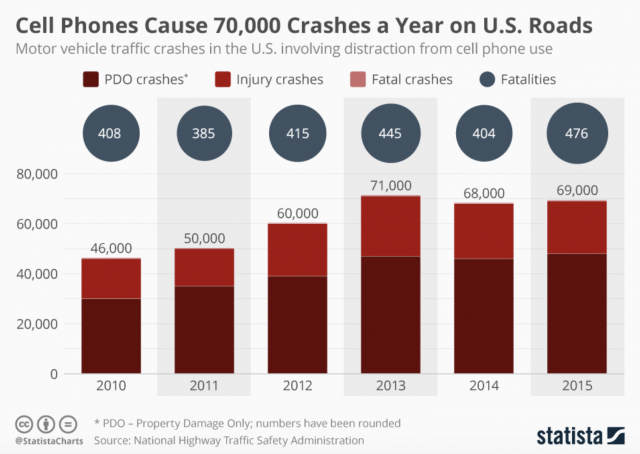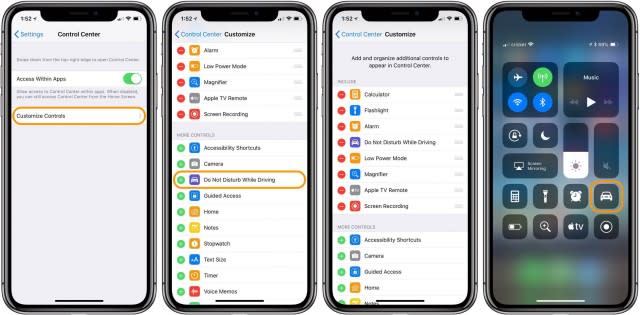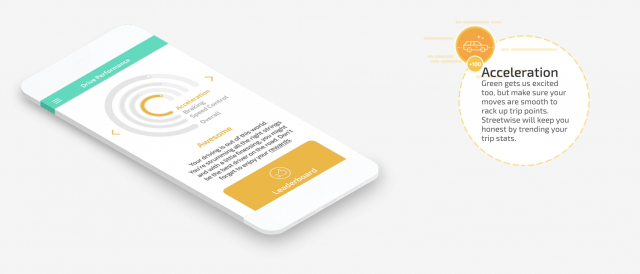How AI is protecting us from phone-wielding drivers
Don’t read this if you’re driving now
Wherever you go and whatever you do in your daily lives, safety should be guaranteed.
However, as an increasing number of drivers use their mobile phones at the wheel, road safety is becoming more of a concern.
For instance, the act of using mobile phones while driving is responsible for one death every 10 days in the UK, but thankfully, new preventative measures are establishing the groundwork for safer roads, and AI is leading the way.
In the US, mobile phone cause approximately 70,000 crashes a year.

Image Source: Statista
It was recently reported that in Sydney, Australia, police have been pioneering a new kind of camera technology that’s designed to catch drivers using their handphones, despite clandestine attempts to keep their usage at the wheel out of view.
After a successful trial period in October 2018, which led to over 11,000 drivers being handed fines, the first-of-its-kind camera is being rolled out to the areas of the city in a bid to beat growing mobile phone usage at the wheel and encourage safer driving.
The technology works by utilising radar-based sensor systems which take detailed photographs through the windscreens of vehicles. Duties then get passed on to a dedicated AI processor that analyses the image for clear evidence of wrongdoing.
The usage of mobile phones among drivers is rife in Australia, with the University of Queensland estimating that one in four domestic road accidents are directly caused by distractions from our handsets.
It’s hoped that these measures not only punish drivers for breaking the law, but also change their mindsets on accessing their phone while driving – ultimately saving lives.
Preventative measures
The measures taken by Sydney’s police highlight the pertinent need to nip the use of phones while driving in the bud, but their preventative technology isn’t the only piece of AI in place.
With the arrival of iOS 11, iPhone users were handed a built-in new feature for their handsets entitled ‘Do Not Disturb While Driving’ – a mode that blocks incoming calls, messages and any other notification when it senses that you’re travelling at speed.
Also Read: Intudo Ventures closes US$50M “Indonesia-only” second fund
The feature aims to strike a mutually beneficial balance that allows keeping their device by their side without the threat of distraction.
This technology is also available on Android handsets, while some apps like Pokemon Go have also utilised the technology in a bid to ensure that all focus remains on the road.
The ‘Do Not Disturb While Driving’ function also features a convenient auto-reply option where the user can send an automated reply to the other party without needing to break concentration.

Image Source: 9to5 Mac
Another cool feature that can potentially prevent drivers from using their phones is the face unlock.
The newer iPhone versions (which run on A11 and A12 Bionic according to SmartphoneChecker) use TrueDepth camera which allows users to unlock the phone using a facial recognition technology instead of a passcode.
This means that to use the phone whilst steering, drivers will have to position the phone right in front of the face.
Although this may even make things worse with careless drivers, the vast majority of drivers will be hesitant to risk being caught looking directly at their phones.
While this technology is potentially life-saving it’s in need of some fine-tuning.
Because mobile phones are such invaluable sources of entertainment and escapism, the ‘Do Not Disturb While Driving’ feature can’t be enforced because handsets are not yet smart enough to differentiate between driver and passenger.
Users who regularly commute to and from work on public transport would also suffer as a result. Hence, the feature is capable of being turned off with ease.
An optional ‘Do Not Disturb While Driving’ feature is no doubt an excellent addition to any smartphone, but its effectiveness is negated by the fact that the service is optional — meaning that any driver can override the function and continue to use their phone at the wheel as before.
Fortunately, there are apps available that actively incentivise safe driving.
Also Read: 5 Asian countries that are emerging as tech leaders
These apps could really help in building new levels of motivation for mobile phone addicts to part with their device through the course of a journey.
Streetwise, for example, is an app that uses GPS to monitor a user’s performance behind the wheel.

Image Source: Streetwise
It measures acceleration, braking and speed control and hands out points based on how well the driver performs.
Points can then be converted into freebies from participating companies like Subway, Marriott, Puma and GNC.
Another nifty application that’s been developed with the sole aim of rewarding drivers for overcoming mobile distractions is Mojo.
The app simply runs in the background and needs no user input, and then rates your level of concentration on the road on a score out of 100. If your concentration breaks and you check your mobile, your rating will suffer.
Like Streetwise, Mojo offers rewards for high-performing drivers as a form of incentive that can be redeemed in return for rewards and vouchers.
Both Streetwise and Mojo are available on iOS and Android app stores for free.
—
Image Credits: andreypopov
e27 publishes relevant guest contributions from the community. Share your honest opinions and expert knowledge by submitting your content here.
The post How AI is protecting us from phone-wielding drivers appeared first on e27.



